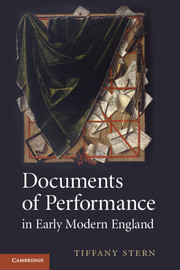Book contents
- Frontmatter
- Contents
- Acknowledgements
- Textual note
- Introduction: Playwrights as play-patchers
- 1 Plot-scenarios
- 2 Playbills and title-pages
- 3 ‘Arguments’ in playhouse and book
- 4 Prologues, epilogues, interim entertainments
- 5 Songs and masques
- 6 Scrolls
- 7 Backstage-plots
- 8 The approved ‘book’ and actors' parts
- Conclusion: Repatching the play
- Notes
- Bibliography
- Index
Conclusion: Repatching the play
Published online by Cambridge University Press: 18 December 2009
- Frontmatter
- Contents
- Acknowledgements
- Textual note
- Introduction: Playwrights as play-patchers
- 1 Plot-scenarios
- 2 Playbills and title-pages
- 3 ‘Arguments’ in playhouse and book
- 4 Prologues, epilogues, interim entertainments
- 5 Songs and masques
- 6 Scrolls
- 7 Backstage-plots
- 8 The approved ‘book’ and actors' parts
- Conclusion: Repatching the play
- Notes
- Bibliography
- Index
Summary
Full printed and manuscript plays contain ‘shadows’ of their patchwork construction, and this book has shown what can be learnt about entire texts by considering what the ramifications are of writing and adapting plays by the patch. It has shown that papers likely to be taken onto the stage physically, like songs, scrolls or prologues, will not always have been written into the playbook – or at least not accurately – so that the more textual a performance moment was, the less precise the ‘book’ for that section might be. But it has also shown reverse moments, when a book's internal scrolls are more accurate than the rest of the text, because they have come to the printing house directly from the theatre and still in ‘stage’ form, integrated and ‘placed’ by the compositor. And, sometimes, it has shown ‘exclusive’ stage documents for special occasions, like the Argument that tells the story of the play, or the occasional prologue, enwrapped into a printed text, as though the book depicts a first or court performance.
In other ways, too, Documents of Performance has shown how elemental the ‘patch’ was to the construction of performance and thence to the construction of playbooks. The dialogue and all that happens within that dialogue exchange was in performance made up of separate manuscripts: learnt actors' parts; backstage-plots; and songs, scrolls, prologues and epilogues all of which might be read onstage, and all of which have their own histories.
- Type
- Chapter
- Information
- Documents of Performance in Early Modern England , pp. 253 - 256Publisher: Cambridge University PressPrint publication year: 2009

